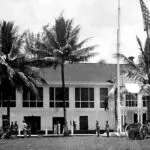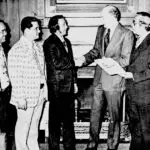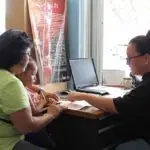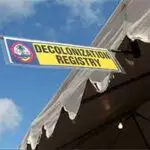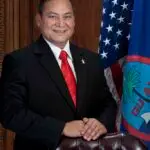Commission on Decolonization
Table of Contents
Share This
The Commission on Decolonization was established by the 24th Guam Legislature in 1997 to enhance the efforts of the Commission on Self-Determination. Its purpose is to educate the people of Guam of the various political status options available, should Guam be allowed to pursue a change in its political status and relationship with the United States. The Commission on Decolonization, however, was inactive for several years during the 2000s. Governor Edward A. Calvo relaunched the Commission on Decolonization in 2011 and appointed the current commission chairman, Edward Alvarez. The Commission on Decolonization is comprised of ten members of the community and the Governor of Guam, and is administered by the Governor’s Office.
Background
In December 1960, the United Nations General Assembly adopted resolution 1514 (XV), formally titled the Declaration on the Granting of Independence to Colonial Countries and People asserting that all people and all nations have the equal right to self-determination. Self-determination is defined as an inherent right belonging to every people to decide their political fate. Resolution 1514 called for an end to colonialism, especially for the non-self-governing territories around the world. The non-self-governing territories are defined as those places “whose people have not yet attained a full measure of self-government.” The resolution asserted that colonialism served as an impediment to world peace and fostered the denial of human rights. Additionally, the resolution obliged the occupying or colonizing nations to ensure that:
Immediate steps shall be taken, in Trust and Non-Self-Governing Territories or all other territories which have not yet attained independence, to transfer all powers to the peoples of those territories, without any conditions or reservations, in accordance with their freely expressed will and desire, without any distinction as to race, creed or colour, in order to enable them to enjoy complete independence and freedom.
The resolution set off a wave of decolonization efforts around the world, as many former territories negotiated new political statuses and relationships. Today, however, Guam remains on the UN list of 16 Non-Self-Governing Territories.
Complementing Resolution 1514 (XV) the UN released Resolution 1541 (XV) which affirmed three options by which a non-self-governing territory could be considered having exercised a full measure of self-government. These options are:
- Emergence as a sovereign independent State;
- Free association with an independent State as the result of a free and voluntary choice by the people of a territory through an “informed and democratic process.”
- Integration with an independent State on the basis of complete equality in status, rights of citizenship, representation, opportunities and freedoms between the people of the Territory and the State. Like free association, integration should be the result of free and voluntary expressed choice through an informed democratic process.
In 1961, the UN General Assembly created the Special Committee on Decolonization, comprised of members nominated by the President of the General Assembly to “examine the application of the Declaration (1514), to make suggestions and recommendations on the progress and extent of the implementations of the Declaration, and to report to the General Assembly.” Every year, the Committee holds seminars and sessions, and prepares working papers to help the UN better understand the conditions in the remaining non-self-governing territories. The Committee also makes recommendations for resolutions to protect the interests of the peoples of these territories.
Overview of Guam’s quest toward decolonization
Guam is in a unique position among the non-self-governing territories of the world because of its long colonial history. Although the Organic Act of 1950 and its subsequent amendments afforded the people of Guam limited self-government and other rights and protections, Guam essentially remains under the control of the US Congress. With the options offered by the UN Resolution, Guam has struggled to change its political status and relationship with the United States government and achieve a “full measure of self-government.” However, Guam’s small size and strategic location have made the US government unwilling to make any significant changes to the island’s political status.
In the early and mid-1970s, Guam leaders created special commissions on Political Status to examine the island’s political conditions, the desires of Guam’s people, and the various options available to them regarding the island’s relationship with the United States. The first Political Status Commission was organized by the 12th Guam Legislature in 1973 to critically assess the economic, social and cultural factors impacted by the island’s political status and to explore the possibilities a changed status would bring to the people of Guam. The second Political Status Commission established by the 13th Guam Legislature in 1975 was tasked with taking the findings of the first Political Status Commission and begin educating the general public about the different political status options, as well as to negotiate a new status with the federal government.
Around the same time, through the urging of then congressional Guam Delegate Antonio Won Pat, the US government authorized Guam and the US Virgin Islands to draft their own constitutions. Won Pat argued that a constitution represented an alternate approach to address Guam’s needs and deal with the island’s political status. The Political Status Commission, however, objected to this approach, asserting that any effort to draft a constitution should arise from a political status chosen by the people of Guam. Nevertheless, a constitutional convention was held in 1976.
Local indigenous grassroots activist groups began to organize in opposition to the official efforts of the Constitutional Convention (ConCon), such as the Peoples Alliance for Responsible Alternatives and the Peoples Alliance for Dignified Alternatives (PARA-PADA) and the Guam Landowners Association (GLA). The ConCon resulted in a draft constitution the following year, which was rejected by the Guam electorate in a 1979 referendum. The constitution was seen as very restrictive and left little room for Guam to address specific issues such as land, immigration and transportation. The US government had tried to argue that a constitution would fulfill the requirements of self-determination, but the UN Special Commission did not agree, and Guam remained on the non-self-governing territories list.
The Political Status Commission meanwhile tried to conduct public hearings on the different political status options. Initially, the Legislature proposed the establishment of a special committee to draft a Territorial-Federal Relations Act, or a combined political status/constitutional convention. Again, activist groups in particular were against these proposals, arguing that a self-determination approach would be the most effective way to address Guam’s political status. This argument was bolstered with the release of a White House Report on Territories in 1979 which asserted that Guam and the other US territories should not have the options of independence or statehood. Guam’s strategic military importance in the western Pacific region and its small size were seen as significant reasons to oppose the island’s complete break from or integration into the United States. However, Guam leaders presented a united front in opposition to the findings of the report and argued that Guam had the right to pursue and exercise its right to self-determination, per the UN Charter.
In fact, informal polls and official plebiscites throughout this period showed shifts in people’s attitudes regarding the various options of independence, statehood, status quo, free association and commonwealth. A plebiscite in 1976 showed that voters supported status quo with some changes, but by the official plebiscites in 1982, voters supported and committed island leaders to seek commonwealth status. However, it was still unclear among most voters what a change in political status might mean for the people of Guam.
The first and second Commissions on Self-Determination
In 1980, Public Law 15-128 was passed creating the Commission on Self-Determination for the People of Guam. The Commission was tasked with ascertaining the desire of the people of Guam regarding the island’s political status and to represent Guam in status negotiations with the US government. The Commission also had to establish task forces for the different political status options; to conduct an educational campaign; and to organize a plebiscite.
The Commission defined Chamorros as “all those born on Guam before 1 August 1950, and their descendants.” The definition created controversy among various groups on Guam, for not being inclusive of other people living on Guam, but also for not being definitive enough in acknowledging Chamorros as a specific, distinct ethnic group. The question of who is the “self” in “self-determination” became the focus of the Commission, and was important because it defined who would or should be allowed to vote on Guam’s political future.
Nevertheless, in January 1982, only a small percentage of Guam voters participated in the first plebiscite, with commonwealth and statehood receiving the largest number of votes. A runoff plebiscite was held in September, coinciding with the primary elections, and commonwealth received overwhelming support.
A year later in 1983, Governor Ricardo Bordallo, along with other delegates from Guam, met with representatives from the House Interior and Insular Affairs Committee in Albuquerque, New Mexico to discuss a strategy that would help advance a change in political status for Guam in Congress. The Guam delegates agreed to draft a Commonwealth Act to be submitted to Congress for review. The Guam Legislature then established in January 1984 the Second Commission on Self-Determination with members from all three branches of government and both political parties. The Commission was tasked with drafting a Federal-Territorial relations act (the Guam Commonwealth Act) which would replace the 1950 Organic Act and establish Commonwealth status for Guam. Four working drafts were drawn up, but Working Draft No. 4 was completed in 1984 and sent to Washington officials. However, Working Draft No. 4 did not address the important issue of Chamorro self-determination and indigenous rights. Calls by local activist groups for the draft to address Chamorro self-determination, as well as opposition by Filipino and stateside residents to proposed immigration controls, made the draft a political hot potato. By the time of the final drafting in late 1985, the proposed Commonwealth Act had become controversial in both Guam and the nation’s capital.
The Legislature was unable to set up a plebiscite vote on the Commonwealth Act immediately. The year 1986 was a gubernatorial election year, and the legislature requested a plebiscite for April. However, the plebiscite was delayed, pending changes in key legislative committees. Considerations of changing the voting format—from an article-by-article vote to one that involved the whole act—also delayed setting the plebiscite date. A lawsuit to further delay the plebiscite was filed but dismissed, and voting took place in August 1987. Two of the articles were rejected and rewritten, and a special election was held in November. With the approval of the majority of voters, the Guam Commonwealth Act was ready to be sent for approval by the US government.
However, beginning in 1988 up through 1997, Guam’s congressional delegates Ben Blaz and Robert Underwood tried to get the Commonwealth Act passed in Congress. From the 100th to the 105th Congresses, the Guam Commonwealth Act failed to receive approval and the political aspirations of Guam as represented by the Commonwealth Act were never realized.
The Commission on Decolonization
In 1997, Senator Hope Cristobal introduced a bill which became Public Law 23-147. This law established a Commission on Decolonization “for the implementation and exercise of Chamorro Self-Determination.” The Legislature contended that the US designation of Guam as a non-self-governing territory meant that the US indeed recognizes that the native inhabitants of Guam have the right to one day exercise their collective self-determination through a decolonization process. The Legislature’s intent was to have Guam’s native inhabitants decide their future political status from options including Independence, Free Association or US Statehood. The law defined native inhabitants as “those persons who became US Citizens by virtue of the authority and enactment of the 1950 Organic Act of Guam and descendants of those persons.”
The Commission was to be composed of eleven members, including the chairperson. The governor of Guam would be the chairperson and two members of the Commission would be selected by the governor. The chairperson of the Legislature’s committee responsible for Federal Affairs would be the vice-chairperson. Other members would include the speaker or one appointed by the speaker, a member of the Legislature minority; a member from the Mayors Council, an advocate of Independence, an advocate of Free Association, and an advocate of Statehood. A youth member, appointed by the Speaker of the Guam Youth Congress, was also to be included. The staff of the Commission on Self-Determination would be the staff for the Commission on Decolonization.
The general purpose of the Commission on Decolonization as mandated by law is to determine the intent of the native inhabitants of Guam as to what they desire for their future political relationship or status with the US. Each political status option is headed by a task force that gathers input from the community. The Commission, along with each task force, is then mandated to conduct an extensive public education program and outreach to ensure a successful plebiscite. The Commission and the Guam Election Commission, with consultation from the executive and legislative branches, will then organize a plebiscite, following the public education program.
The three options, Statehood, Independence and Free Association with the US, will be allowed on the ballot. The choices are not limited to the three political status options, and there may be other status options on the ballot, such as commonwealth or incorporated status. Persons eligible to participate in the plebiscite “shall include those persons designated as Native Inhabitants of Guam…18 years of age or older and are registered voters on Guam.” The date of the plebiscite furthermore, “shall be held on a date of the General Election at which seventy percent of eligible voters…have been registered as determined by the Guam Election Commission.”
A decolonization plebiscite was to be scheduled in conjunction with the 2000 general elections on Guam, but the Guam Election Commission was unable to establish the required voter registration of seventy percent. In addition, the lack of funding to conduct a public education outreach campaign hindered a plebiscite for the 2000 elections.
The Commission on Decolonization was inactive for most of the administration under Governor Felix Camacho from 2002 to 2010. However, the Calvo-Tenorio Administration relaunched the Commission, and an Executive Director was appointed in 2011. Calvo convened a public forum to assess the public’s opinion on Guam’s political status, and then appointed the members of the Commission with the goal of addressing the political status issue.
Although the Commission has since had a mixed reception in the Guam community, the challenges facing the latest incarnation of the Commission on Decolonization remain. Funding for the Commission and the three task forces has been difficult to secure. In addition, the lack of information accessible to the general public about the specific details of what a plebiscite would entail, along with a pending federal lawsuit about the qualification of “native inhabitant” as a requirement to be part of the Chamorro Registry have contributed to the delay in scheduling.
In November 2011, a retired US Air Force officer, Arnold “Dave” Davis, filed a lawsuit in the District Court of Guam against the Territory of Guam, the Guam Election Commission and the Attorney General of Guam. Represented by the Center for Individual Rights, an American advocacy group based in Washington, DC, Davis cited the occasion in which he tried to be included in the Decolonization Registry and was rejected because he did not qualify as a “native inhabitant of Guam.” Although the suit was dismissed in local court because no plebiscite has been officially scheduled, Davis and his attorneys have appealed.
Guam Decolonization Registry
While the Commission on Decolonization was set up to conduct a plebiscite on Guam’s political status, the people who would participate need to register with the Guam Decolonization Registry. Public Law 25-106:2 defines the Guam Decolonization Registry as separate and apart from the Chamorro Registry (authorized by PL 12-130) and would specifically delineate the list of qualified voters for the plebiscite. The Legislature, in putting forth this law, also stressed that the Decolonization Registry would not be based on race.
Again, the intent was to allow people who were defined as “native inhabitants” of Guam as naturalized by the Organic Act of 1950 and their descendants to register. The registry also is open to persons who are not on Guam but who otherwise fill the stated requirements. Currently, the Guam Election Commission states that there are a little over 6,000 people who have signed up for the Decolonization Registry; there are over 46,000 people who are registered to vote in Guam’s elections.
The Commission on Decolonization’s future goals
The future of the Commission on Decolonization’s efforts is unclear. The Commission held its first meeting in September 2011, the first one in over six years. The Commission then began networking with the Guam Election Commission to develop a strategy to build the Decolonization Registry. The Commission on Decolonization determined that the plebiscite vote could not be set until it secured the money for the education program.
As of August 2013, the Commission is still seeking funding to start its public information campaign to educate voters about the process of conducting a plebiscite for self-determination and the different options that are being considered. According to commission director Alvarez, the cost will be about $1 million for the education program. Urging the Legislature to consider adopting a measure allowing the Commission to accept donations, Alvarez suggested that media outlets be granted a tax credit to donate air time or print space for the Commission’s education campaign and advertisements. Commission member Eddie Duenas, however, has pointed out that the governor’s office should provide funding for the program, since the Commission is administered under the Office of the Governor. The task force position papers for Independence, Statehood and Independence are still in progress, but will address issues of self-determination, immigration, trade, commerce, national defense and foreign affairs.
The Commission on Decolonization continues to communicate with the United Nations Special Committee and has requested that experts be sent to Guam to reignite the discussion on self-determination, as well as to engage with different UN divisions involved with political and indigenous rights. In addition, the Commission wants to network with representatives from the other US territories like American Samoa and Puerto Rico, as well as international groups from Okinawa and Taiwan to raise awareness and encourage advocacy for Guam’s self-determination.
For further reading
Ada, Joseph, and Leland Bettis. “The Quest for Commonwealth, the Quest for Change.” Kinalamten Pulitikåt: Siñenten I Chamorro (Issues in Guam’s Political Development: The Chamorro Perspective). The Hale’-ta Series. Hagåtña: Political Status Education Coordinating Commission, 1996.
Leibowitz, Arnold H. Defining Status: A Comprehensive Analysis of United States Territorial Relation. Leiden: Martinus Nijhoff, 1989.
Supreme Court of Guam Compiler of Laws. “Chapter 21. Commission on Decolonization for the Implementation and Exercise of Chamorro Self-Determination.” Title 1: General Provisions, Guam Code Annotated. Last modified 29 October 2021.
––– “Chapter 21. Guam Decolonization Registry.” Title 3. Elections, Guam Code Annotated. Last modified 22 August 2013.
United Nations. United Nations and Decolonization. New York: United Nations Department of Public Information, 2001.

